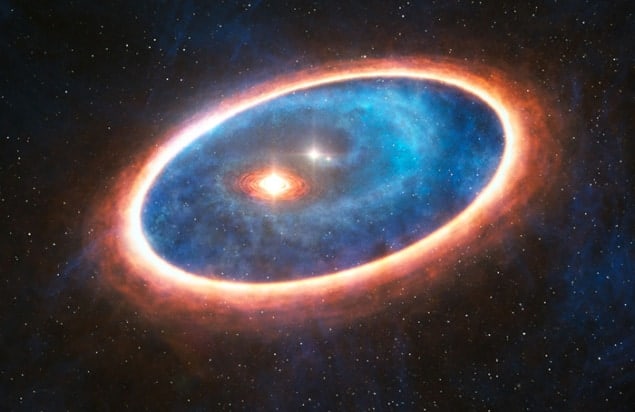
Astronomers using the ALMA array of radio telescopes in Chile are the first to see a streamer of gas and dust flowing towards a single star in a binary system. This material is crucial for sustaining the formation of planets, and the observation could explain how planets can form around single stars in a binary system – something that had puzzled astronomers. This has important implications for astronomers studying planets outside of the solar system, because almost half of the Sun-like stars that we know of were formed in binary systems.
Astronomers have so far discovered more than 1800 planets orbiting stars other than the Sun. One striking thing about these exosolar planets – or exoplanets – is that they exist in a variety of systems, many of which are very different to our own solar system and include binary star systems. Sometimes planets in binary systems orbit both stars, and follow large “circumbinary” orbits. In other cases, planets will orbit tightly around one of the stars in a binary system.
Creation mystery
It is this latter case that has puzzled astronomers, because it is not clear how such planets could form. The mystery is illustrated nicely by the subject of this latest study: a young system called GG Tau A that is 450 light-years away, and actually comprises three stars. Two of the stars orbit each other tightly, and a third star is some distance away. As a result, the third star (called GG Tau Aa) can essentially be thought of as one half of a binary system.
The system is surrounded by a large outer disc of dust and gas that orbits all three of the stars. One of its stars – GG Tau Aa – is also surrounded by its own compact inner disc of dust and gas, with a total mass on par with that of Jupiter. There is very little dust and gas in the large gap between the inner disc and outer disc, because the competing gravitational forces of the stars prevent matter from accumulating in this intermediate region.
Vanishing trick
The inner disc of GG Tau Aa has enough material to form planets, but its existence has puzzled astronomers. The problem is that matter is falling into the star at a very high rate, and therefore the disc should have vanished long ago. One possibility is that gas and dust is streaming in from the outer disc something that has been predicted by computer simulation, but not yet seen. But now, Anne Dutrey and colleagues at the University of Bordeaux, along with astronomers in Mexico, the US, France and Taiwan, have used ALMA to discover such a stream of gas and dust flowing from the outer disc, and into the inner disc around GG Tau Aa.
“These observations demonstrate that material from the outer disc can sustain the inner disc for a long time,” explains Dutrey. “This has major consequences for potential planet formation.” Indeed, she points out that an Earth-like planet could form within the habitable zone of GG Tau Aa – the region in which life could develop on such a planet. However, Dutrey cautions that the study does not allow the team to conclude that a planet will form around GG Tau Aa, but rather that there is enough material for this to happen.
Common sight
If this streaming process occurs in other star systems, it could mean that planets are a common sight around single stars in binary systems. Team member Emmanuel Di Folco of the University of Bordeaux explains why this is exciting: “Almost half the Sun-like stars were born in binary systems. This means that we have found a mechanism to sustain planet formation that applies to a significant number of stars in the Milky Way.”
The discovery is described in Nature.
- There is much more about the formation of exoplanets in this feature article by Michael Meyer of ETH Zurich: “Recipes for planet formation”.



